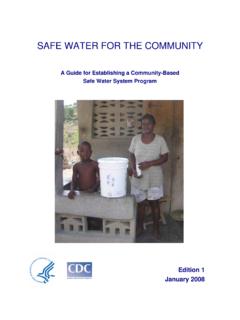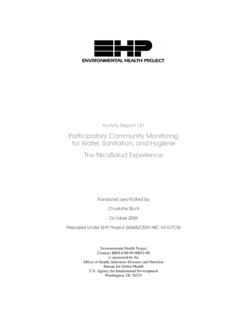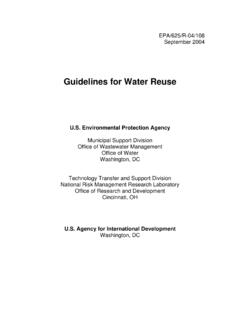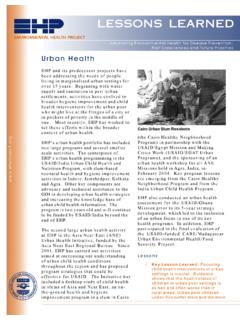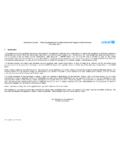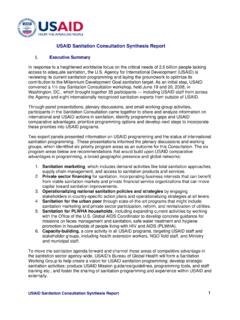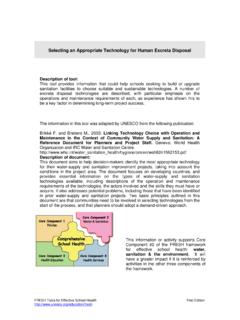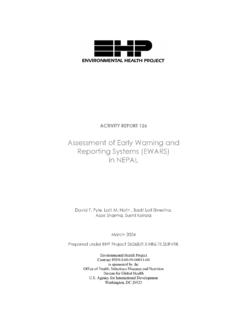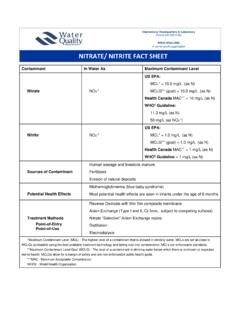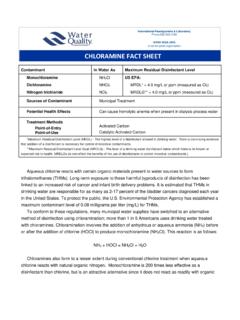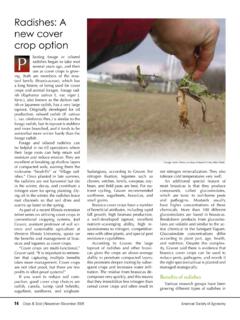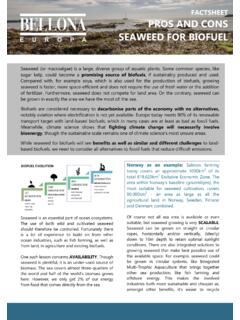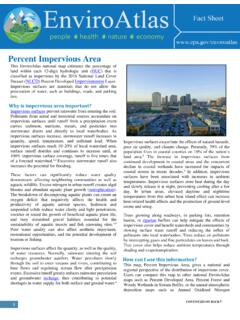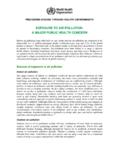Transcription of Chlorine Residual Testing Fact Sheet
1 Chlorine Residual Testing fact Sheet , CDC SWS Project, Residual Testing fact SheetThe presence of free Chlorine Residual in drinking water indicates that: 1) a sufficient amount ofchlorine was added to the water to inactivate most of the bacteria and viruses that cause diarrhealdisease; and, 2) the water is protected from recontamination during transport to the home, andduring storage of water in the household. Because the presence of free Residual Chlorine indrinking water indicates the likely absence of disease-causing organisms, it is used as onemeasure of the potability of drinking fact Sheet describes:1. The processes that occur when Chlorine is added to water, and the definitions involvedwith these processes;2. Why and how the Safe Water System program recommends Testing of free Chlorine ; and,3.
2 methods to test free Chlorine in the field in developing Chlorine is added to water as a disinfectant, a series of reactions occurs. These reactionsare graphically depicted on the following page. The first of these reactions occurs when organicmaterials and metals present in the water react with the Chlorine and transform it into compoundsthat are unavailable for disinfection. The amount of Chlorine used in these reactions is termedthe Chlorine demand of the water. Any remaining Chlorine concentration after the chlorinedemand is met is termed total Chlorine . total Chlorine is further subdivided into: 1) the amountof Chlorine that then reacts with nitrates present in the water and is transformed into compoundsthat are much less effective disinfectants than free Chlorine (termed combined Chlorine ); and, 2)the free Chlorine , which is the Chlorine available to inactivate disease-causing organisms, and isthus a measure used to determine the potability of example, when Chlorine is added to completely pure water the Chlorine demand will be zero,and there will be no nitrates present, so no combined Chlorine will be formed.
3 Thus, the freechlorine concentration will be equal to the concentration of Chlorine added. When Chlorine isadded to natural waters, especially water from surface sources such as rivers, organic materialwill exert a Chlorine demand, and combined Chlorine will be formed by reaction with , the free Chlorine concentration will be less than the concentration of Chlorine Residual Testing fact Sheet , CDC SWS Project, Addition Flow ChartChlorine AddedInitial Chlorine concentrationadded to waterFree ChlorineConcentration of chlorineavailable for disinfectionCombined ChlorineConcentration of chlorinecombined with nitrogen in thewater and not as effective fordisinfectionTotal ChlorineRemaining chlorineconcentration after chlorinedemand of waterChlorine DemandReactions with organicmaterial, metals.
4 Othercompounds present in waterprior to disinfectionChlorine Residual Testing fact Sheet , CDC SWS Project, Why Do We Test Free Chlorine in Drinking Water?The CDC Safe Water System (SWS) program is an intervention proven to reduce diarrhealdisease incidence in developing countries that consists of three elements: water treatment withdilute sodium hypochlorite at the point-of-us; storage of water in a safe container; and, educationto improve hygiene and water and food handling practices. The sodium hypochlorite solution isgenerally packaged in a bottle with directions instructing users to add one full bottle cap of thesolution to clear water (or 2 caps to turbid water) in a standard-sized storage container, agitate,and wait 30 minutes before CDC SWS project recommends Testing free Chlorine in the following circumstances: To conduct dosage Testing in project areas before starting an SWS program To monitor and evaluate projects by Testing stored drinking water in householdsThe goal of dosage Testing is to determine how much sodium hypochlorite solution to add towater that will be used for drinking to maintain free Chlorine Residual in the water for the averagetime of storage of water in the household (typically 24 hours).
5 This goal differs from the goal ofinfrastructure-based (piped) water treatment systems, whose aim is effective disinfection at theendpoints ( , water taps) of the system. The WHO recommends a Residual concentration offree Chlorine of greater than or equal to mg/litre after at least 30 minutes contact time at pHless than This definition is only appropriate for users who obtain water directly from aflowing tap. A free Chlorine level of mg/L can maintain the quality of water through adistribution network, but is not optimal to maintain the quality of the water when it is stored inthe home in a bucket or jerry can for 24 , CDC recommends in SWS programs that:1. At 1 hour after the addition of sodium hypochlorite solution to water there should beno more than mg/L of free Chlorine Residual present (this ensures the water doesnot have an unpleasant taste or odor).
6 2. At 24 hours after the addition of sodium hypochlorite to water in containers that areused by families for water storage there should be a minimum of mg/L of freechlorine Residual present (this ensures microbiologically clean water). Chlorine Residual Testing fact Sheet , CDC SWS Project, methodology is approved by the WHO, and is graphically depicted below. The maximumallowable WHO value for free Chlorine Residual in drinking water is 5 mg/L. The minimumrecommended WHO value for free Chlorine Residual in treated drinking water is mg/L. CDCrecommends not exceeding mg/L due to taste concerns, and Chlorine Residual decays overtime in stored MaximumTaste ThresholdSample Decay CurveWHO MinimumThe SWS project recommends Testing free Chlorine in homes of SWS users to evaluate whetheror not users are using the SWS (as measured by presence or absence of free Chlorine Residual )and whether they are using it correctly (as measured by free Chlorine residuals in the range).
7 This approach is useful for program monitoring because the presence of freechlorine residuals in stored water obtained from an unchlorinated source is an objective,quantitative measure that people are using the SWS hypochlorite Residual Testing fact Sheet , CDC SWS Project, to Test Free Chlorine in the Field in Developing CountriesThere are four main methods to test free and total Chlorine Residual in drinking water in the fieldin developing countries: 1) Pool test kits; 2) Color-change test tubes; 3) Color-wheel test kits;and, 4) Digital colorimeters. All four methods depend on a color change to identify the presenceof Chlorine , and a measurement of the intensity of that color to determine how much Chlorine ispresent. This fact Sheet does not consider commercial test strips for Chlorine Residual Testing ,because of their relatively higher cost ( USD) per test.
8 When only a small number oftests are needed it is possible that commercial test strips could be a viable, cost-effective Pool test kitsThe first option for Chlorine Residual Testing uses the liquid chemical OTO (othotolidine) that,when added to water with total Chlorine in it, causes a color change to yellow. To complete thetest, users simply fill a tube with water, add 1-5 drops of the solution, and look for the colorchange to yellow. These kits are sold in many stores as a way to test the concentration of totalchlorine in swimming pool water. This method does not measure free of the pool test kits are: Low cost Very easy to use Easily purchasableDrawbacks of the pool test kits are: Degradation of the OTO solution can causeinaccurate readings over time Generally not reliable quantitative results Lack of calibration and standardization Measurement of total Chlorine , not free chlorineCost and Ordering InformationPool test kits can be obtained from many home supply and pool stores at a cost of approximately $5-20 Residual Testing fact Sheet , CDC SWS Project, Test-tube DPD color comparatorThe Lamotte Company developed a rapid presence/absence test kit for free Chlorine Residual inresponse to the 2004 tsunami in Indonesia.
9 The test tube color comparator uses DPD (N,Ndiethyl-p-phenylene diamine) tablets that causes a color change to pink in the presence ofchlorine. To use the kit, users add 5 mL of water to the test tube, add one rapidly dissolvingDPD-1R tablet, and compare the results to a color chart. This kit combines the simplicity of thepool test kits, with the benefit of Testing for free Chlorine Residual instead of total chlorineresidual. To use this kit to measure total Chlorine , a DPD-4R tablet can be added instead of theDPD-1R tablet to the water sample, or a DPD-3R tablet can be added to the sample water afterthe DPD-1R tablet has been added and the free Chlorine Residual has been read. Although thetest kit is not available as a package from Lamotte, the individual components (test tube, DPDtablets, and color chart) can be ordered individually.
10 Test kit instructions and part numbers canbe found at: of the test tube kit are: Low cost Very easy to use Measurement of free chlorineDrawbacks of the test tube kit are: Generally not reliable quantitative results Lack of calibration and standardizationCost and Ordering InformationThe kit parts are available from the Lamotte Company ( ) for a cost ofapproximately$5 for both the test tube and color comparator chart, and approximately $70 for1,000 DPD Residual Testing fact Sheet , CDC SWS Project, Color wheel test kitsColor wheel test kits also use DPD tablets or powder that, when added to water with free or totalchlorine present in it, cause a color change to pink. The color wheel test kits are more accuratethan the pool test kits / test tube DPD color comparators and simpler and less expensive thandigital meters.
